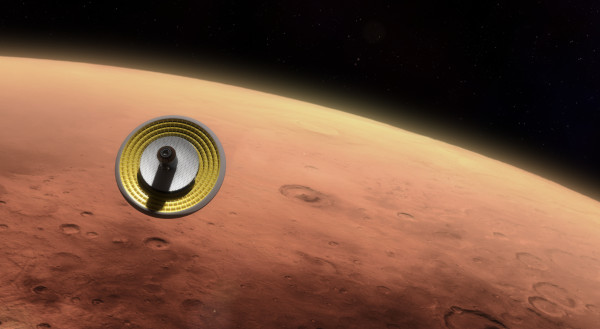NASA wants to produce fuel for spacecraft right on Mars
Fuel used to send spacecraft carrying astronaut astronauts back to Earth can be produced right on the red planet, by extracting oxygen and liquid methane from groundwater.
NASA wants to produce fuel on Mars
According to National Geographic, 33 tons of propellant is needed to bring the MAV spacecraft that NASA is developing to escape the gravity of Mars, flying to a transition place to return to Earth.
This mass of fuel, along with research equipment, is too heavy and cumbersome to send from Earth, so scientists will directly produce it on Mars.
MAV will have a volume of about 18 tons, the heaviest device to fly to Mars. The Curiosity robot working on Mars only has a mass of about one ton. The production of flying fuel on Mars will help NASA reduce a few tons of the spacecraft's mass.
Because Mars' atmosphere is so thin, the density is only about one percent of the Earth's atmosphere, it will not help much for deceleration. MAV will need a special gear reducer, cone, inflated and insulated mode. It will reduce the speed of the MAV from the supersonic (Mach 5) to a level that exceeds the speed of sound (Mach 1). At this speed, the engine's missile can control the landing process.

The deceleration and insulation device is used when MAV starts to enter the Martian atmosphere.(Photo: National Geographic).
After landing, MAV will begin the process of producing fuel to fly back. The elements needed to produce methane fuel (CH 4 ) and liquid oxygen are carbon, hydrogen and oxygen can all be exploited here. In theory, it is possible to extract oxygen from CO 2 , which accounts for 95% of the Martian atmosphere, from water and ice below the surface. The carbon and hydrogen remaining after oxygen separation will be used to produce liquid methane.
However, to drill into the ground for water, it is necessary to be sure that the landing site has groundwater. Therefore, the backup plan is that engineers will have to design so that MAV can contain hydrogen from Earth.
"Hydro is very light, but it also needs very large containers, occupying a lot of space on the spacecraft. MAV will then be higher and narrow, this shape will affect the landing process, as well as the operation. astronauts' movement , said Michelle Rucker, systems engineer at NASA's Johnson Space Center.
A more likely plan is to launch another spacecraft to transport liquid methane, along with the equipment needed to extract oxygen from the Martian atmosphere.
This process will take about two years. After the fuel tanks were full, new scientists flew to Mars, assured that there was enough fuel for them to return to Earth.
Another problem arises because of liquefied petroleum gas, it needs to be kept at a very low temperature before being used.
"After getting the fuel, it's necessary to keep it cold for a year or two before using it without boiling it," Rucker said. Therefore, the first priority is to research the manufacture of super-tight valves for fuel tanks , according to Tara Polsgrove, NASA's aerospace engineer.

The astronauts' attire on the way back to Earth.(Photo: NASA).
In addition, attention should also be paid to time factors. MAV takes one to two years to produce fuel. Then the crew needed 200 to 350 days to fly to Mars. Working time here is about 500 days. Thus, MAV will have to stay on Mars for a total of about 4 years. It needs to be built strong enough to withstand huge dust storms and ultraviolet rays from the universe.
Some of the equipment of the fuel manufacturing process will be left on Mars, which is infrastructure, not only for fuel production, but also for expanding the country and air for exploration projects. after that.
In terms of costumes, astronauts will not be able to wear suits that work on Mars to return to Earth, as it is heavy, bulky, and full of Martian dust. It is very dangerous to bring Mars dust to Earth without any treatment. These clothes will be left on Mars and recovered later. They must replace the orange IVA outfit , the outfit they used during the process of leaving Earth. Its advantages are lighter, easier to move and most importantly, it does not stick to Mars dust.
- NASA will create fuel for missiles from ... Mars land
- NASA's Maven spacecraft approached Mars
- NASA tested the spacecraft to send people to Mars
- NASA spacecraft almost crashed into Mars's Moon
- NASA spacecraft runs out of fuel after a 7 billion km journey
- NASA tested a UFO-like spacecraft
- NASA spacecraft completes 60,000 rings around Mars
- Why does the spacecraft fly for hundreds of years without running out of fuel?
- The NASA ship found robots landing on Mars
- NASA revealed technology to send people to Mars
- NASA spacecraft discovered anomaly in oxygen on Mars
- America is about to launch a ship to Mars
 Van Allen's belt and evidence that the Apollo 11 mission to the Moon was myth
Van Allen's belt and evidence that the Apollo 11 mission to the Moon was myth The levels of civilization in the universe (Kardashev scale)
The levels of civilization in the universe (Kardashev scale) Today Mars, the sun and the Earth are aligned
Today Mars, the sun and the Earth are aligned The Amazon owner announced a secret plan to build a space base for thousands of people
The Amazon owner announced a secret plan to build a space base for thousands of people